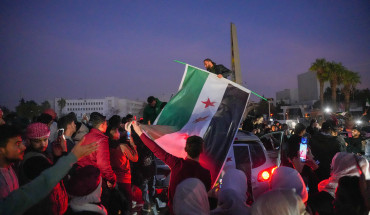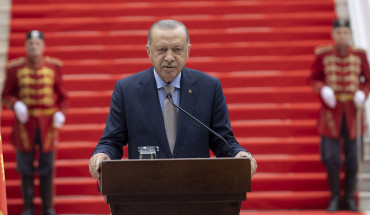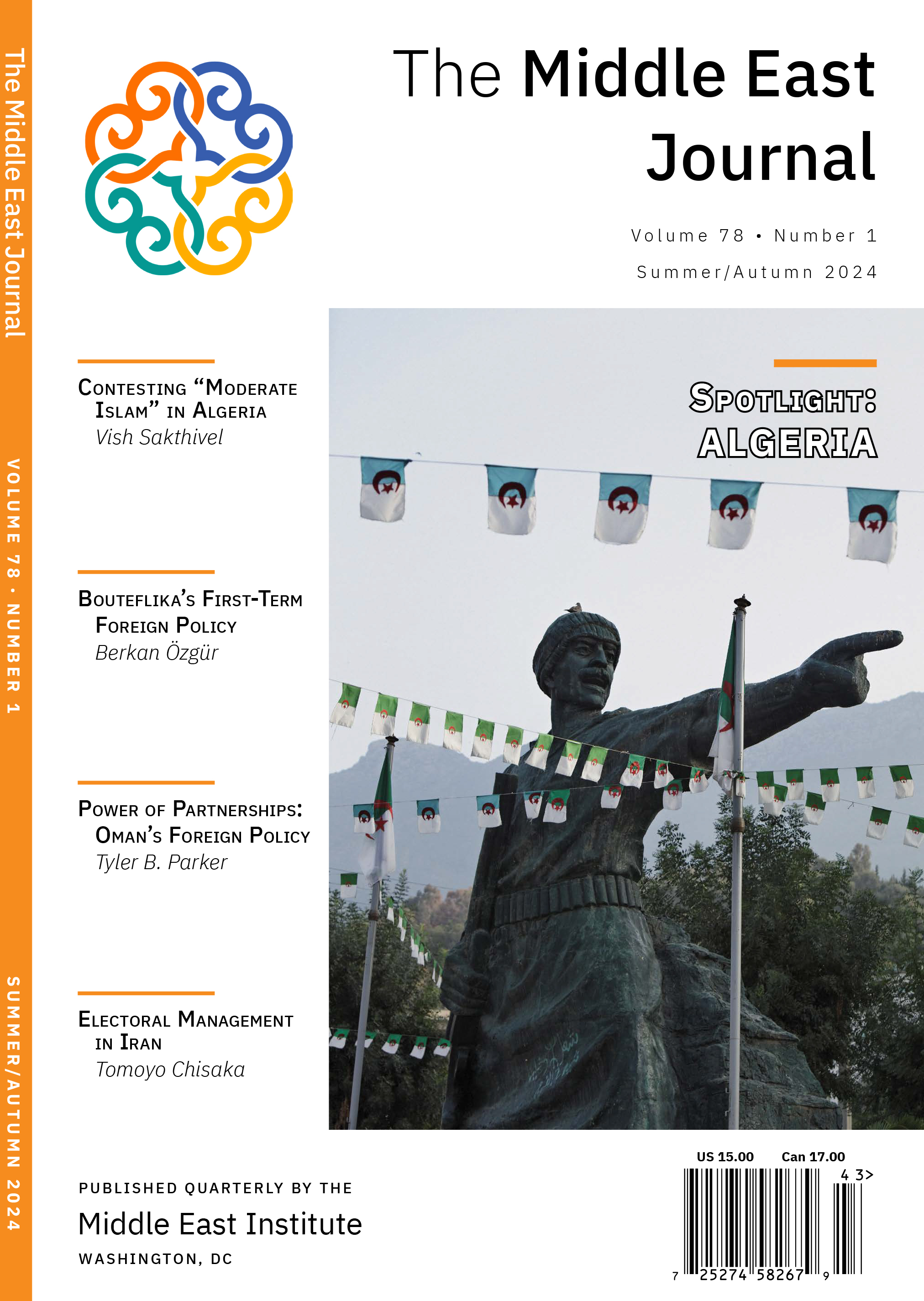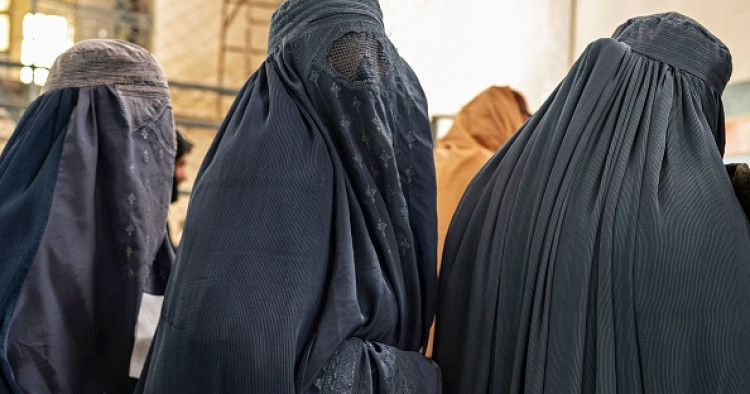This piece is part of the series “All About China”—a journey into the history and diverse culture of China through short articles that shed light on the lasting imprint of China’s past encounters with the Islamic world as well as an exploration of the increasingly vibrant and complex dynamics of contemporary Sino-Middle Eastern relations. Read more ...
Three major issues have dominated the US’s engagement and policy focus on Afghanistan since its withdrawal in 2021: 1) airlifting remaining US citizens, Lawful Permanent Resident (LPRs) and allies, relocate and find permanent resettlement for their Afghan allies in the US; 2) addressing the worsening humanitarian and economic crises; and 3) pressuring the Taliban to address protect human rights. Even though the US has not legitimized the Taliban, Washington has been compelled to have a limited degree of engagement with the group to address these two issues. To date, American posturing with the Taliban can be characterized as cautious engagement, whereby the US refuses to lift sanctions, unblock foreign reserves and give diplomatic recognition.[3] As the Taliban faces greater isolation in the international arena, it is likely to pivot closer to Beijing for diplomatic and financial support.
Erosion of Women’s Rights and Freedoms Despite Assurances
Shortly after Kabul fell to the Taliban in August 2021, the group’s revival was accompanied by a diplomatic charm offensive including its first press conference held on August 17, 2021 that sought to soften the group’s hardline image, provide assurances that it will set up a representative and inclusive government, not resort to reprisals and protect the rights of women and minorities. However, there was a lack of clarity on what the Taliban meant when it said that women could study and work “within the framework of Islam.”[4] Despite these guarantees, many women fled the country because they knew that the group was likely to backtrack on its promises.[5] One of the most repressive measures was the replacement of the Ministry of Women Affairs and with the Ministry of Vice and Virtue, the latter tasked with moral policing.[6] That ministry has arguably imposed harsher restrictions on Afghan women during its rule this time, including instructing them to cover fully in public spaces.[7]
In December 2022, the Taliban issued a decree prohibiting Afghan women from working in NGOs, and had given a similar order a few days earlier banning women from studying in universities.[8] The group has also shut down domestic violence shelters, detained and arrested female demonstrators, and restricted female access to public health. Since the Taliban’s return to power, it has restricted girls from studying in secondary schools and most women from working, taking part in sports, and travelling without a male counterpart.[9] Although international media reporting has focused mostly on the changes taking place in Kabul, the situation is much worse in other areas, and especially challenging in remote places that have little access to the media and digital services.[10]
The growing restrictions on Afghan women demonstrates how decades of gains on women’s rights and gender equality can be undone in a short time span. The lives of women, who are being excluded from public life, have gone back 20 years. Many Afghans who are opposing the Taliban’s repressive rule are young women and girls under the age of 30 who did not experience life during the group’s first rule. The access to basic freedoms during the US-led intervention became the norm for them and hence it is agonizing to see their fundamental rights being taken away suddenly.
The changing situation on the ground provides clear evidence that the Taliban still harbors a hardline version of the Deobandi movement and majoritarian Pashtun nationalism.[11] Nonetheless Taliban 2.0 does have a better understanding of regional and geopolitical dynamics in comparison to when it was first in power.[12] It should be noted that a large segment of Afghan society is conservative, particularly in the rural areas, and does not oppose the Taliban’s values and views on women’s issues. Even when the Taliban was not in power, it was not uncommon for parents to take their girls out of school in conservative areas of the country. Ellinor Zeino has said that there are two ways to safeguard human and women’s rights: first, to pursue counter-arguments on the interpretation of Islam and not let the Taliban monopolize it; and second, to ensure that they are compatible with Islam.[13]
Human rights groups, in response to the growing restrictions and violations of rights, have urged countries to disengage from the Talban, including boycotting bilateral meeting, limiting all communication, making economic assistance conditional, imposing travel bans on the group’s leaders and freezing their bank accounts.[14] Not fulfilling expectations and promises on good governance, human rights, and counterterrorism will hamper the Taliban’s ability to access humanitarian and economic aid.[15]
However, some experts do not think stringent measures adopted by international actors will deter the Taliban from resorting to repression. Kambiz Ghawami, executive chairman of the German Committee of the World University Service, has said that linking international assistance with human rights demands is clearly not working and is unlikely to compel the Taliban to honor the fundamental rights of women.[16] The US strategy of isolating the Taliban with punitive measures has limited success, partly due to the latter’s options of engagement with regional countries that seek to increase their clout, particularly China.
Great-Power Competition: Who is Winning?
Afghanistan is once again caught in the middle of great-power rivalry over natural resources, geopolitical, geostrategic and security issues. The US-led withdrawal of Afghanistan resulted in de-Americanization of the region, making way for a new type of proxy politics with greater complexity and with more regional players seeking to secure their range of strategic, economic and security interests.[17] While the former Afghan government forged a loose alliance between the West and other democracies like India, under the Taliban’s rule, Pakistan, Russia, China, and Iran are likely to play a bigger role in the country as part of a realignment that can change the geopolitics of the region.[18]
The ouster of the former Afghan government has necessitated both commitment and contingency from regional powers to deal with the new establishment and the new order in the country. The international community finds itself in a dilemma, not regarding ‘whether’ to engage the Taliban, but rather on ‘how’ and on ‘what terms’, along with reconciling with the ethical, moral, and political processes. Although no country has accorded the Taliban diplomatic recognition, the reality is that the group is here to stay, and this tacit acceptance has prompted some countries to reopen their embassies in Afghanistan.[19] For many regional countries, including China, engaging with the Taliban is regarded as a necessity rather than a form of support for or endorsement of the regime.
China’s engagement with the new regime on trade, economic- and security-related matters has been robust. Beijing has held almost weekly meetings with Taliban representatives in Afghanistan in recent months to discuss various investment and economic deals, and the latter has reciprocated by reserving key mining projects for the former. Economic investments and political support from Beijing are one of the few opportunities left for the Taliban as foreign reserves and sanctions remain in place. The Taliban is aware of China’s economic power, although the latter was not a big player when the group was in power in the 1990s.[20]
In efforts to court China, the Taliban has also sought to protect Buddha statues in the country, a key departure from its previous stance when former Taliban leader Mullah Omar ordered the destruction of the famous Buddha statues in Bamiyan in 2001.[21] The group is now offering natural resources to Beijing in exchange for economic projects after realizing that its political establishment may struggle to survive as a hermit state amid international sanctions and blocking of foreign reserves. Moreover, the various factions will need a strong finance portfolio to secure their vested interests and future, both against one another and as part of a state. It should be noted that Beijing’s engagement in Kabul is not a new phenomenon; it started signing deals with the former Afghan government in power, mining and oilfield sectors a decade ago (however the insecure environment prevented substantial progress).[22] Kabir Taneja contends that although Beijing, through promising economic and investment projects, can be a gamechanger in Kabul, other regional and neighboring actors may have a better understanding of the security situation and the Taliban’s Islamic politics.[23]
Other experts, such as Jennifer Brick Murtazashvili, have argued that China’s economic and infrastructure engagement in Afghanistan is motivated by security interests, such as extremist or insurgent activity spilling over into its territory or destabilizing the region. The main security and terrorist threat for China comes from anti-China groups, particularly the East Turkestan Islamic Movement (ETIM), a Xinjiang based insurgent group. It’s in Beijing’s interest to have a functioning government in place in Afghanistan that has a monopoly on violence and fulfils its security commitments to other countries. Beijing is seeking security guarantees from the Taliban and at the same time is trying to increase development in the country over fears that poverty would result in greater instability.[24]
However, Chinese engagement in Afghanistan has been limited in scope in pursuit of protecting its own interests and advancing its own narrative in the short-to-medium term. Beijing’s relations with the Taliban are driven by pragmatism and are part of its traditional foreign policy approach of noninterference, respecting sovereignty and the domestic matters of its partner countries. Interfering in Kabul’s internal affairs will only happen if Beijing’s wider interests — security, as well as economic and strategic investments — are impacted.[25] Moreover, openly condemning the Taliban for its repressive measures and erosion of women’s rights could create a precedent for international actors to criticize China’s own record of human rights, particularly in Xinjiang.
Another reason is flexibility. While the international community is constrained by its adherence to universal principles of human rights, even though such posturing can burn bridges and not necessarily pressurize the alleged perpetrator to address these concerns, Beijing is not committed to such values and ethos.[26] Unlike the West, which has openly pressed the Taliban to form an inclusive government and respect human rights, Beijing has merely encouraged the upholding of these commitments rather than making bilateral engagement conditional on progress towards fulfilling them.[27] China’s somewhat indifferent attitude to the Taliban’s poor women’s rights and human rights records may provide the Taliban a feasible option to ignore demands by the international community on these issues.
Beijing adopted a similar position of not openly and officially condemning the atrocities committed by the Tatmadaw following its clearance operation in Rakhine state in August 2017. There is a pattern in Beijing narrowing down the root causes of a highly protracted conflict to its the economic aspects instead of acknowledging the socio-political, ethnocentric and religious dimensions, and by large the complexities involved. It also demonstrates a deeply entrenched, but opportune, Chinese narrative that does not give priority to fundamental issues of human rights, civil liberties and sectarianism.[28]
Conclusion
Many Afghans were not surprised when the Taliban started reversing the gains made in women and human rights, particularly for those who lived under the group’s former rule in the 1990s. What has disappointed them was how countries who pushed for the protection of human rights and fundamental freedoms for years suddenly lost interest in safeguarding and addressing these issues. Hence, there are sentiments of abandonment by the international community. Nonetheless, many Afghan women are likely to continue to speak out and protest, despite the imminent risks and lack of foreign support for their cause.[29]
Although the Taliban has not unleashed a genocide or ethnic cleansing campaign against women and minority groups, the group has blatantly and grossly undermined civil liberties and human rights. A comprehensive report commissioned by the UN alleged that the group resorted to torture, extrajudicial killings, crackdown on peaceful protest and free speech, arbitrary detentions and restricting women’s access to freedom, work and education. USIP expert Andrew Watkins said the Taliban has become more authoritarian in relative to the group’s former rule in the 1990s.[30]
When it comes to humanitarian and economic aid, this lever is unlikely to pressurize the Taliban to stop repressive tactics and non-inclusive form of governance. Beijing’s non-interventionist and pragmatic policies in Afghanistan frees the Taliban to ignore international demands to protect human rights, at least for the time being.
It is likely that the US will continue to find it challenging to push the Taliban to institute positive change, given Washington’s self-imposed restrictions on engaging the regime, preoccupation with the Ukraine war, and geopolitical limitations. While the US should continue to press the Taliban to honor its commitments, such efforts should be undertaken within a broader strategy, one that acknowledges the importance of, and promotes regional cooperation aimed at contributing to the longer-term stability of Afghanistan and its immediate neighborhood.[31] China might find such an approach appealing, given the potential risks and costs either of assuming sole responsibility for regional stability or seeking to harvest material benefits while remaining indifferent to it. The recent joint statement issued by China and Iran urging the Taliban to end restrictions on women’s work and education,[32] though unexpected, is an encouraging sign Beijing recognizes that an inclusive Afghan society is ultimately in its own interest.
[1] Akmal Davi, “Women in Afghanistan facing numerous Taliban restrictions in 2022,” VOX, December 24, 2022, https://www.voanews.com/a/women-in-afghanistan-facing-numerous-taliban-restrictions-in-2022/6868501.html#:~:text=The%20Taliban%20banned%20women%20from,on%20women's%20rights%20and%20freedoms.&text=Throughout%202022%2C%20the%20ruling%20Taliban,seen%20anywhere%20in%20the%20world.
[2] Imran Ahmed, “One year of Taliban rule: Continuity and change in Afghanistan,” ISAS Brief, No. 957, August 26, 2022, https://www.isas.nus.edu.sg/papers/one-year-of-taliban-rule-continuity-and-change-in-afghanistan/.
[3] Kersten Knipp, “Will the Taliban allow full education for girls,” DW, January 1, 2022, https://www.dw.com/en/how-serious-are-the-taliban-about-full-education-for-girls/a-60611971.
[4] Vinay Kaura, “The Taliban and the formation of a new Afghan government,” Middle East Institute, August 24, 2021, https://www.mei.edu/publications/taliban-and-formation-new-afghan-government.
[5] “2022: The year Taliban cracked down on women’s rights,” Al Jazeera, December 31, 2022, https://www.aljazeera.com/gallery/2022/12/31/afghanistan-2022.
[6] “Taliban replaces ministry for women with ‘guidance’ ministry,” Al Jazeera, September 18, 2021, https://www.aljazeera.com/news/2021/9/18/taliban-replace-ministry-for-women-with-guidance-ministry.
[7] Horia Mosadiq and Lisa Toremark, “Women’s rights under threat in Taliban-run Afghanistan,” Chatham House, June 10, 2022, https://www.chathamhouse.org/2022/06/womens-rights-under-threat-taliban-run-afghanistan.
[8] Baktash Siawash, “Taliban erasing women from society in Afghanistan,” The Diplomat, December 28, 2022, https://thediplomat.com/2022/12/taliban-erasing-women-from-society-in-afghanistan/.
[9] Ibid.
[10] Mosadiq and Toremark, “Women’s rights under threat in Taliban-run Afghanistan.”
[11] Zalmai Nishat et al., “Why do people in Afghanistan object to Taliban rule,” Tony Blair Institute for Global Change, September 22, 2022, https://institute.global/policy/why-do-people-afghanistan-object-taliban-rule.
[12] Kaura, “The Taliban and the formation of a new Afghan government.”
[13] Knipp, “Will the Taliban allow full education for girls?”
[14] Baktash Siawash, “Taliban erasing women from society in Afghanistan,” The Diplomat, December 28, 2022, https://thediplomat.com/2022/12/taliban-erasing-women-from-society-in-afghanistan/.
[15] Kate Bateman, “A year after the Taliban takeover: What’s next for the U.S. in Afghanistan,” United States Institute of Peace, August 11, 2022, https://www.usip.org/publications/2022/08/year-after-taliban-takeover-whats-next-us-afghanistan.
[16] Knipp, “Will the Taliban allow full education for girls..
[17] Murtazashvili, “China’s activities and influence in South and Central Asia.”
[18] Tamim Asey, “A game as old as empire: The return of proxy war in Afghanistan,” Small Wars Journal, June 12, 2018, https://smallwarsjournal.com/jrnl/art/game-old-empire-return-proxy-wars-afghanistan.
[19] Ahmed, “One year of Taliban rule: Continuity and change in Afghanistan.”
[20] Kabir Taneja, “China’s Afghanistan strategy may be in trouble,” Observer Research Foundation, December 23, 2022, https://www.orfonline.org/expert-speak/chinas-afghanistan-strategy-may-be-in-trouble/.
[21] “With eye to China investment, Taliban now to preserve Buddhas,” The Economic Times, March 27, 2022, https://economictimes.indiatimes.com/news/international/world-news/with-eye-to-china-investment-taliban-now-preserve-buddhas/articleshow/90477469.cms?from=mdr.
[22] BM Jain, “China’s geostrategic engagement in a new Afghanistan,” East Asia Forum, October 8, 2021, https://www.eastasiaforum.org/2021/10/08/chinas-geostrategic-engagement-in-a-new-afghanistan/.
[23] Taneja, “China’s Afghanistan strategy may be in trouble.”
[24] Murtazashvili, “China’s activities and influence in South and Central Asia.”
[25] Jason Li, “Conflict mediation with Chinese characteristics: How China justifies its non-interference policy,” Stimson Center, August 27, 2019, https://www.stimson.org/2019/conflict-mediation-chinese-characteristics-how-china-justifies-its-non-interference-policy/.
[26] Adrienne Joy, “Understanding China’s response of the Rakhine crisis,” United States Institute of Peace, Special Report 419, February 2018, p. 4, https://www.usip.org/sites/default/files/2018-02/sr419-understanding-chinas-response-to-the-rakhine-crisis.pdf.
[27] Murtazashvili, “China’s activities and influence in South and Central Asia.”
[28] Joy, “Understanding China’s response of the Rakhine crisis.”
[29] Mosadiq and Toremark, “Women’s rights under threat in Taliban-run Afghanistan.”
[30] Ahmed, “One year of Taliban rule: Continuity and change in Afghanistan.”
[31] Murtazashvili, “China’s activities and influence in South and Central Asia.”
[32] “China, Iran call on Afghanistan to end restrictions on women,” AP News, February 16, 2023, https://apnews.com/article/afghanistan-iran-politics-government-united-states-d9ef71d7cf5c578dae1350a7910f842b
Photo by WAKIL KOHSAR/AFP via Getty Images
The Middle East Institute (MEI) is an independent, non-partisan, non-for-profit, educational organization. It does not engage in advocacy and its scholars’ opinions are their own. MEI welcomes financial donations, but retains sole editorial control over its work and its publications reflect only the authors’ views. For a listing of MEI donors, please click here.












